<< Previous | Displaying results 3001-3050 of 6769 for "" | Next >>
The shattered stained glass windows of the Zerrennerstrasse synagogue after its destruction on Kristallnacht. Pforzheim, Germany, ca. November 10, 1938.
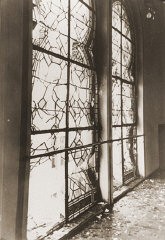
The holy ark in the sanctuary of the Seitenstetten Street synagogue, demolished during Kristallnacht (the "Night of Broken Glass"). Vienna, Austria, after November 9, 1938.
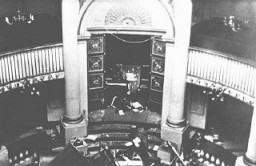
Herzog Rudolfstrasse synagogue after it was destroyed during Kristallnacht (the "Night of Broken Glass"). Munich, Germany, November 1938.
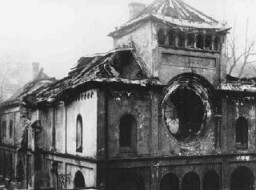
View of barracks and the ammunition factory in one of the first photos of the Dachau concentration camp. Dachau, Germany, March or April 1933.
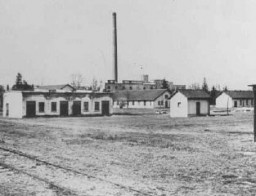
View of the Dachau concentration camp, after liberation on April 29, 1945. It shows the electrified barbed wire fence, the moat, and a watchtower.
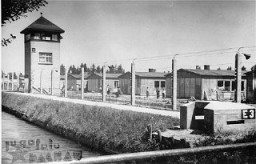
View of prisoners' barracks soon after the liberation of the Dachau concentration camp. Dachau, Germany, May 3, 1945.
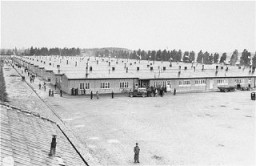
The crematoria at Dachau concentration camp, soon after the liberation of the camp. Germany, after April 29, 1945.
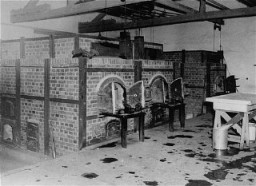
Medical experiment performed at the Dachau concentration camp to determine altitudes at which German pilots could survive. Germany, 1942.
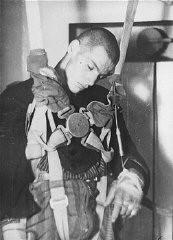
View of barracks after the liberation of Kaufering, a network of subsidiary camps of the Dachau concentration camp. Landsberg-Kaufering, Germany, April 29, 1945.
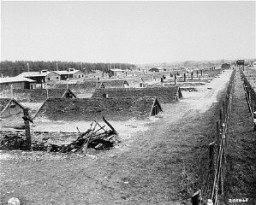
US soldiers view bodies of victims of Kaufering, a network of subsidiary camps of the Dachau concentration camp. Landsberg-Kaufering, Germany, April 30, 1945.
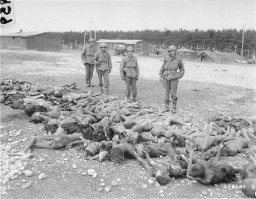
Survivors of the Ampfing subcamp of the Dachau concentration camp soon after liberation by US troops. Ampfing, Germany, May 4, 1945.
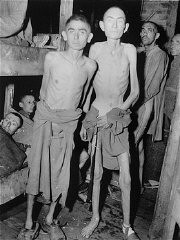
Camp survivors crowded in barracks at liberation. Dachau, Germany, April 29-May 1, 1945.
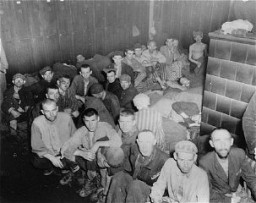

US soldiers discovered these boxcars loaded with dead prisoners outside the Dachau camp. Here, they force German boys—believed to be members of the Hitler Youth (Hitlerjugend; HJ)—to view the atrocity. Dachau, Germany, April 30, 1945.
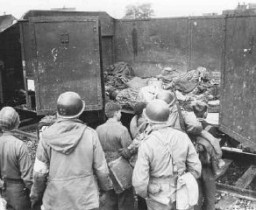
American soldiers finish their inspection of the Dachau camp's first crematorium. Dachau, Germany, November 18, 1945.
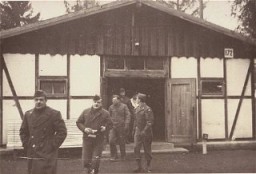
This multistory complex served as the Drancy transit camp. The overwhelming majority of Jews deported from France were held here prior to their deportation. Drancy, France, 1941–44.
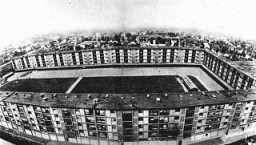
Jewish prisoners arrive at the Drancy transit camp. France, 1942.


Buses waiting at the entrance to the Vélodrome d'Hiver, where almost 13,000 Jews were assembled before being transported to Drancy and other French transit camps. Paris, France, July 16 and 17, 1942.
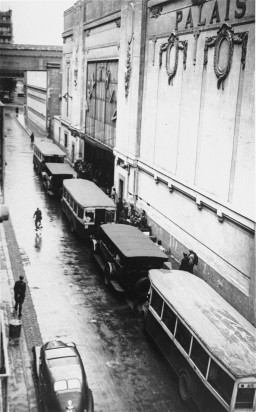
A view of the Westerbork camp, the Netherlands, between 1940 and 1945. From 1942 to 1944 Westerbork served as a transit camp for Dutch Jews before they were deported to killing centers in German-occupied Poland.

The interior of a barracks at the Westerbork transit camp, after liberation. Westerbork, the Netherlands, after April 12, 1945.
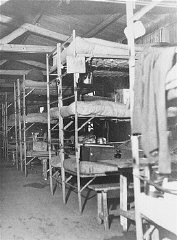
Train station in the Westerbork camp. Westerbork, the Netherlands, between 1942 and 1944. From 1942 to 1944 Westerbork served as a transit camp for Dutch Jews before they were deported to killing centers in German-occupied Poland.
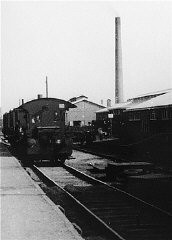
Dutch Jews from Hooghalen during deportation to the Westerbork transit camp. The Netherlands, October 1942.

Arrival of a transport at the Westerbork camp. Westerbork, the Netherlands, October 1942.
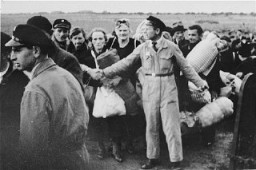
Roll call of the camp Jewish police. Westerbork transit camp, the Netherlands, 1942 or 1943.

Deportation of Jews from the Westerbork transit camp. The Netherlands, 1943.
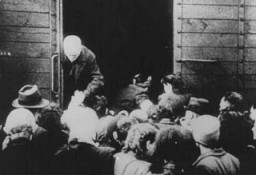
Marzahn, the first internment camp for Roma (Gypsies) in the Third Reich. Germany, date uncertain.

Austrian police round up Romani (Gypsy) families from Vienna for deportation to Poland. Austria, September-December 1939.
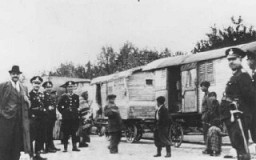
Onlookers watch during the resettlement of Romani (Gypsy) families from Vienna. Austria, September–December 1939.
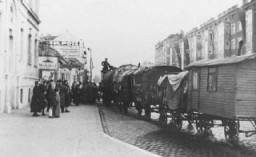
Forced-labor camp for Roma (Gypsies). Lety, Czechoslovakia, wartime.

Romani (Gypsy) women and children interned in the Rivesaltes transit camp. France, spring 1942.
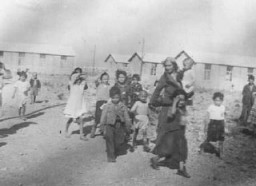
Serbs and Roma (Gypsies) who have been rounded up for deportation. This photograph shows them being marched to Kozare and Jasenovac, both Croatian concentration camps. Yugoslavia, July 1942.
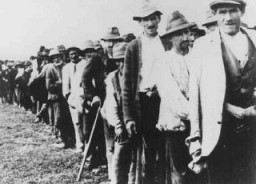
A Romani (Gypsy) victim of Nazi medical experiments to make seawater safe to drink. Dachau concentration camp, Germany, 1944.
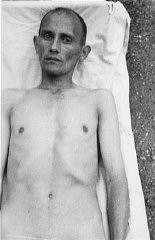
Romani (Gypsy) survivors in a barracks of the Bergen-Belsen concentration camp during liberation. Germany, after April 15, 1945.
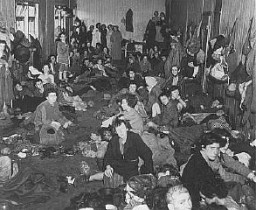
Buses that transported patients from the Eichberg hospital near Wiesbaden to the Hadamar euthanasia center, where the patients were gassed or killed by lethal injection. Germany, between May and September 1941.
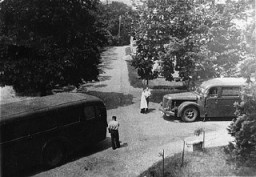
View of Bergen-Belsen concentration camp after the liberation of the camp. A row of small tents has been pitched outside the barracks. A group of survivors huddles in front of one of the tents.
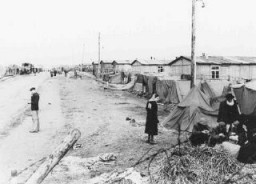
A view of the Bergen-Belsen concentration camp after the liberation of the camp. Bergen-Belsen, after April 15, 1945. The 63rd Anti-tank Regiment and the 11th Armoured Division arrived at the Bergen-Belsen concentration camp on April 15, 1945. When British troops entered the camp, they were totally unprepared for what they found. Inside were about 55,000 prisoners, many of whom were emaciated and ill and in desperate need of medical attention. Thousands of corpses in various stages of decomposition lay…
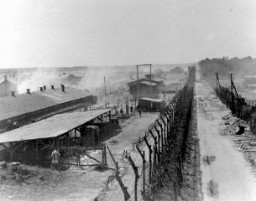
Crematorium oven used in the Bergen-Belsen concentration camp. Photograph taken after the liberation of teh camp. Bergen-Belsen, Germany, April 28, 1945.
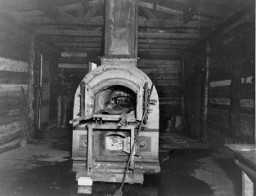
The remains of a crematorium at the Bergen-Belsen concentration camp. This photograph was taken after the liberation of the camp in 1945. Bergen-Belsen, Germany, date uncertain.

After camp liberation, one of the mass graves at the Bergen-Belsen camp. Germany, after April 15, 1945.
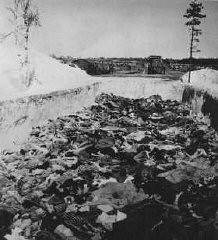
After liberation of the Bergen-Belsen camp, British soldiers forced German mayors from nearby towns to view mass graves. Bergen-Belsen, Germany, after April 15, 1945.
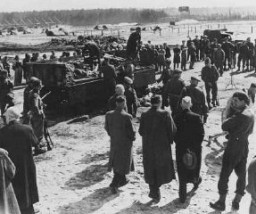
A British soldier watches women SS guards who were forced to carry victims' corpses to mass graves. Bergen-Belsen, Germany, after April 15, 1945.
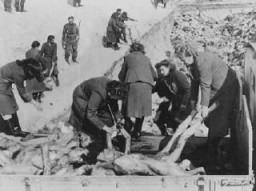
Two survivors in front of the women's barracks in the Bergen-Belsen concentration camp. Bergen-Belsen, Germany, April 1945. © IWM (BU 3740)
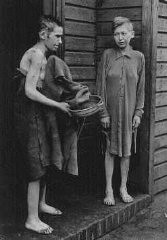
Soon after liberation, camp survivors bathe in outdoor showers set up by the British. Bergen-Belsen, Germany, after April 15, 1945.
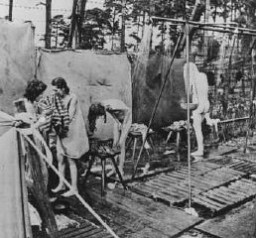
Soon after liberation, camp survivors eat near scattered corpses. Bergen-Belsen, Germany, after April 15, 1945.
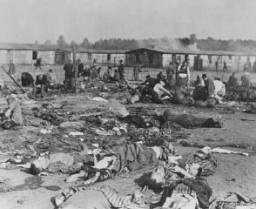
Buildings of the Bergen-Belsen concentration camp are burned to the ground by British soldiers to prevent the spread of typhus. Germany, May 21, 1945.
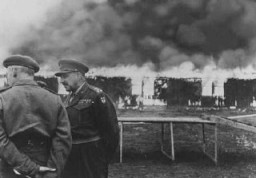
Buildings of the Bergen-Belsen concentration camp is burned to the ground to halt the spread of typhus. Germany, May 21, 1945.
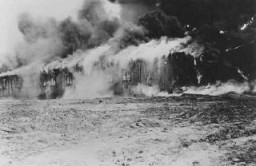
Passport issued to Gertrud Gerda Levy, who left Germany in August 1939 on a Children's Transport (Kindertransport) to Great Britain. Berlin, Germany, August 23, 1939.
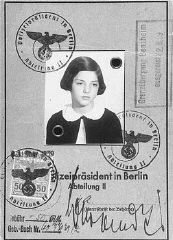
Circular label from the suitcase used by Margot Stern when she was sent on a Kindertransport to England. Germany, December 1938.
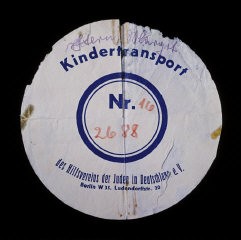
Jewish refugee children, part of a Children's Transport (Kindertransport) from Germany, soon after arriving in Harwich. Great Britain, December 2, 1938.
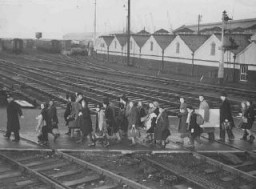
We would like to thank Crown Family Philanthropies, Abe and Ida Cooper Foundation, the Claims Conference, EVZ, and BMF for supporting the ongoing work to create content and resources for the Holocaust Encyclopedia. View the list of donor acknowledgement.